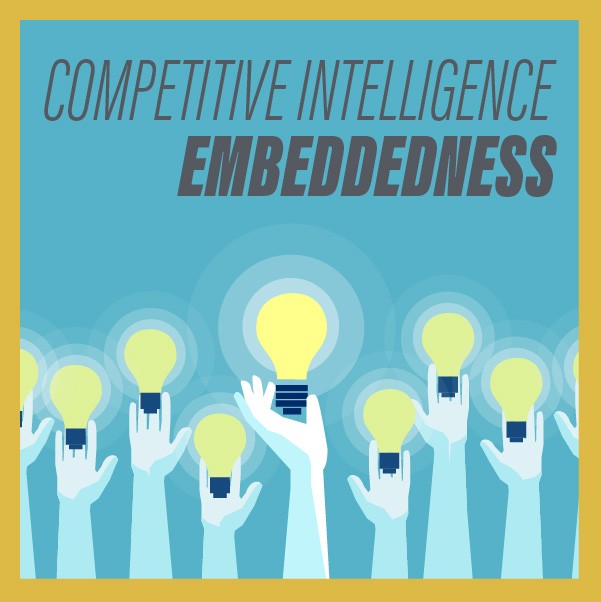Competitive Intelligence Embeddedness
Article
Competitive Intelligence Embeddedness: Drivers and Performance Consequences by Kalanit Efrat, Amiram Markovich, Daphne R. Raban and Anne L. Souchon
Journal
European Management Journal. 2019. Vol. 37, pages 708-718
Reviewer
Dr. Lourival Carmo Monaco Neto, Postdoctoral Research Associate
Summary
Competitive intelligence helps firms to develop a competitive advantage when the entire organization and its networks commit to developing actionable insights. Once reached, this initiative acts as a capability by translating information into unique know-how. Therefore, it is proposed that competitive intelligence embeddedness (CIE) is a capability, defined as the extent to which competitive intelligence permeates the entire organization so that strategic and tactical decisions can be made in the knowledge of all relevant competitive information. This plays a key role in affecting organizational performance.
This study is an empirical examination of how the perceived quality of web competitive information sources and the action-oriented use of this information by managers impacts CIE capability and, in turn, how CIE affects firm performance. A questionnaire was sent to several companies from Israel and answered by 124 managers (senior, CEOs, etc.).
Web information sources were chosen as the main focus in this study because in today’s modern and digitalized world, it is a form of cheap, informal (sometimes formal) information collection. It is becoming increasingly popular as new competitive information channels are constantly being developed, such as digital journalism, search engines, social networks, blogs, forums, YouTube videos, competitor websites and more.
The authors hypothesized that perceived quality of web information sources are positively related to competitive intelligence embeddedness. They found this hypothesis to be true as information overflow interferes with firms’ decision-making abilities and consequently may damage performance. Such overflow — which is often a characteristic of web-based sources of information — often mixes information of different quality levels. Aiming to extract high-quality information enables firms to both reduce the volume of information gathered and improve the quality of decision-making outcomes.
Additionally, the authors found that CIE had a positive impact on customer satisfaction but no direct impact on firm performance, while post hoc analysis revealed a mediation effect of CIE on performance through customer satisfaction. In conclusion, this study explains and demonstrates the concept of competitive intelligence embeddedness and how quality of information drives this capability and contributes to firm performance through customer satisfaction.
What this means for Food and Agricultural Business
The need for competitive intelligence is widely present in the literature, especially now as competitiveness is at one of its highest points. This is due, among other factors, to the digitalization of
data and its increasing ease of access. Nowadays, having the right information at the right time for those who need it is one of the main reasons some companies outperform others in the marketplace.
But in order to achieve its full potential, competitive intelligence needs to permeate all levels of a company and leverage all of its resources (human, assets, knowledge, money, etc.) for better performance and a sustainable competitive advantage. This way of thinking sprouts from the Resource Based View theory in which the capabilities of a company leverages its resources to gain competitive advantage.
Competitive intelligence embeddedness is a capability in which the whole “organizational culture” of a company becomes “intelligence driven”. Thus, all the employees, in one way or another, contribute to the company “intelligence network” through insights, information or any other resources and capabilities they possess. The same concept applies for food and agricultural businesses. When a company in the agribusiness sector engages in competitive intelligence efforts, it needs to be done in a way that lets everyone in the organization understand the importance, requirements and expected results of these efforts. When this is achieved, a firm can truly say it has created an organizational culture change towards an intelligence-driven company.
Findings of this study can be related to research done in Purdue’s Center for Food and Agricultural Business that was presented at the 2019 National Conference. The Center’s National Conference research consisted of farmer and non-farmer surveys over how collected data and information are used across six levels of the value chain, including:
1. Ag Input Manufacturers
2. Ag Retailers
3. Farmers
4. First Handlers/Food Processors
5. Food Manufacturers
6. Food Retailers
National Conference research found that 90+% of surveyed ag input manufacturers use data to support their decisions, showing the importance of data/information on the agribusiness decision-making process. Additionally, results indicated that ag retailers have major problems with data collection and analysis. This finding confirms the article’s argument that with high-quality information, less of it is necessary to achieve intelligence goals and improve company competitive intelligence embeddedness.
The Center’s study also concluded that food manufacturers (and all agents in the value chain) perceive the most important benefit of data/information usage to be improving customer satisfaction, which was indicated in the article to mediate company performance. These findings illustrate that not only results obtained by the reviewed article can be translated to companies in the agribusiness sector, but also that the time to have competitive intelligence embeddedness in these companies is now!
RELATED POSTS:
Optimizing Sales Management: Knowledge, Coaching and Continuous Improvement
While we used to think that exceptional salespeople possessed an innate gift, recent data suggests the impact of today’s sales managers in nurturing and refining this gift to unlock its fullest potential.
A great moment for value-based sales in agribusiness
Value-based sales can empower companies to craft compelling value propositions, understand the customer’s business model and effectively communicate to stakeholders.
How can big data empower the development of new products?
Data is one of the most powerful resources for a company. It enables accurate decision-making and minimizes risk, ensuring greater revenue and sustainable growth.
